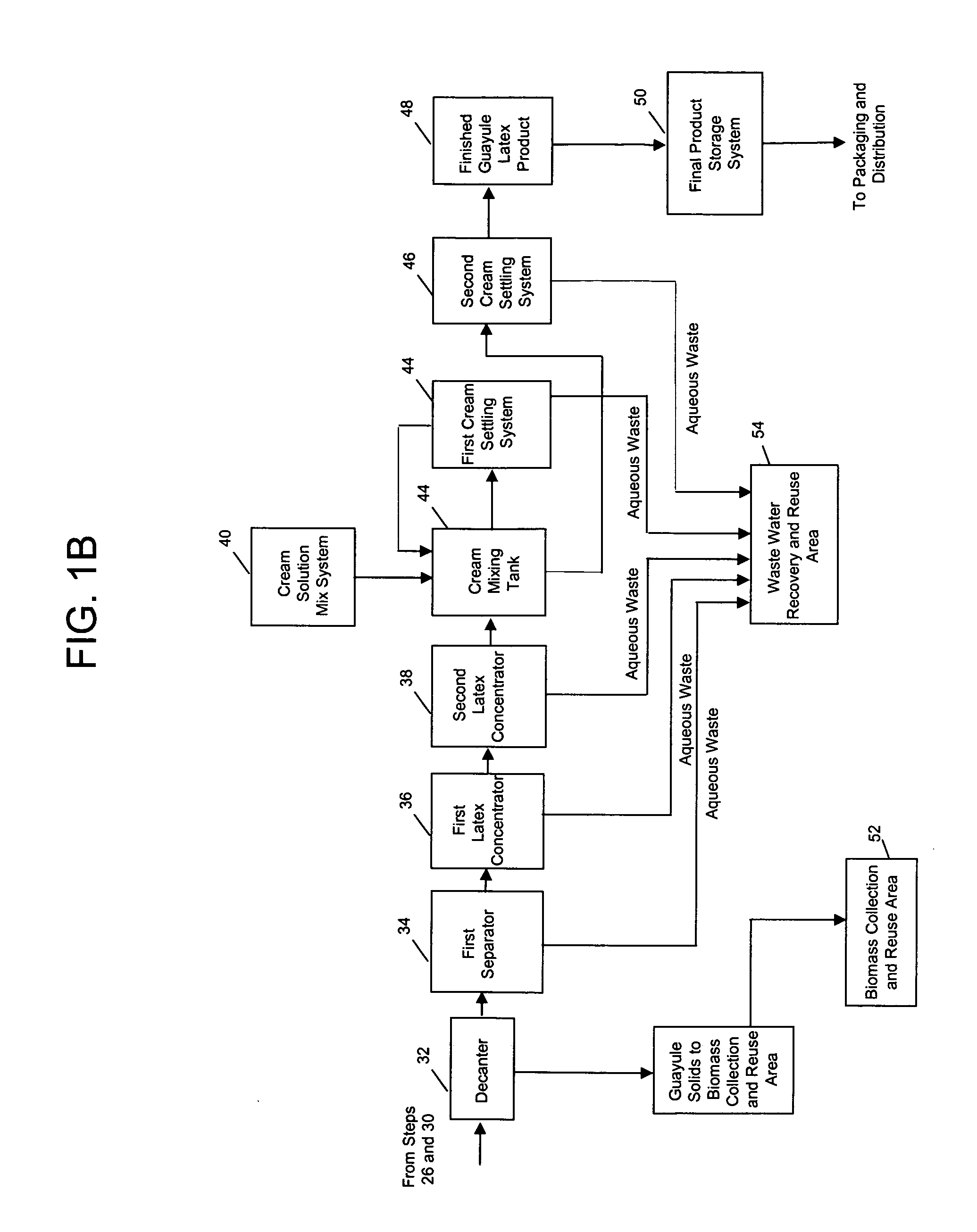Biopolymer extraction from plant materials
a technology of plant materials and biopolymers, which is applied in the directions of plant/algae/fungi/lichens ingredients, differential sedimentation, inks, etc., can solve the problems of limited crop production, high price, and potential diseases and blights on natural rubber sources in these countries
- Summary
- Abstract
- Description
- Claims
- Application Information
AI Technical Summary
Problems solved by technology
Method used
Image
Examples
example 1
Ammonia Antioxidant Chemical Solution System & Milling
[0076] A water-based ammonia antioxidant (“AAO”) solution, containing 695 mL / L ammonium hydroxide (NH4OH) and the anti-microbial bleaching agent 1 g / L sodium sulfite (Na2SO3) is mixed with water by injection. AAO is stored at a pH of 10.5 in 50 gallon tanks, or is alternately processed through the system without storage, at a pH of 10.0. The AAO is pumped into the milling system 22 through the use of solenoids, and combined with guayule plant materials in a wet mill. Plant materials are emulsified to form a slurry. The milling system 22 comprises a wet mill, and more specifically a Schutte-Buffalo Pulverizer Co. (Buffalo, N.Y.) MP-30 grinder, which accepts plant material, conveyed to a hopper of the MP-30, and cuts the plants into relatively uniform pieces of 3-6 inches. The milling system 22 further comprises a belt conveyer, which transferred the ground guayule pieces to a Schutte-Buffalo 1320 hammer mill for hammer-milling.
example 2
Milling System and Pressing Steps
[0077] Following the milling system 22 steps, disclosed in Example 1, guayule plant materials are pressed in a first press 26 step, comprising a screw auger and a Brown International screw press, which presses the liquid slurry through a screen to separate the liquid phase the AAO / dilute latex homogenate from the solid phase. The solid phase bagasse does not pass through the screen. The liquid AAO / dilute latex homogenate slurry is collected in a recirculation tank, and the bagasse drops directly into a Compak Systems, CS Processing Engineering Ltd. (Lincoln, England) paddle washer.
[0078] Any remaining particles of latex are washed from the bagasse in the Compak Systems paddle washer by a pressurized stream of water from a water tank. More specifically, the water tank used in the washing step 28 has a booster pump attached to a high pressure solenoid source, which interfaces water with the homogenate material, and pumps the AAO / latex homogenate to t...
example 3
Separation and Concentration
[0081] After the pressing and decanting steps, as disclosed in Example 2, the latex homogenate is measured to determine the percentage of latex present (desirably about 0.01% to 1% after decanting) and transferred from the decanter 32 to the first separator 34, an Alfa Laval PX-510 high speed centrifuge, and centrifuged for about 15 seconds or less.
[0082] The first separator 34 separates the latex homogenate into a light phase containing latex, and a heavy phase containing waste products. The heavy phase is removed to the waste water recovery area 54, where waste products are recycled for use as a grinding medium or for further cleaning using standard water purification treatments. Following the first separator 34, the latex homogenate is measured to determine the percentage of latex present. Preferably this is about 1% after the first separator 34 step.
[0083] After being separated in the first separator 34, the light phase containing latex is pumped i...
PUM
| Property | Measurement | Unit |
|---|---|---|
| Fraction | aaaaa | aaaaa |
| Fraction | aaaaa | aaaaa |
| Time | aaaaa | aaaaa |
Abstract
Description
Claims
Application Information
 Login to View More
Login to View More - R&D
- Intellectual Property
- Life Sciences
- Materials
- Tech Scout
- Unparalleled Data Quality
- Higher Quality Content
- 60% Fewer Hallucinations
Browse by: Latest US Patents, China's latest patents, Technical Efficacy Thesaurus, Application Domain, Technology Topic, Popular Technical Reports.
© 2025 PatSnap. All rights reserved.Legal|Privacy policy|Modern Slavery Act Transparency Statement|Sitemap|About US| Contact US: help@patsnap.com


